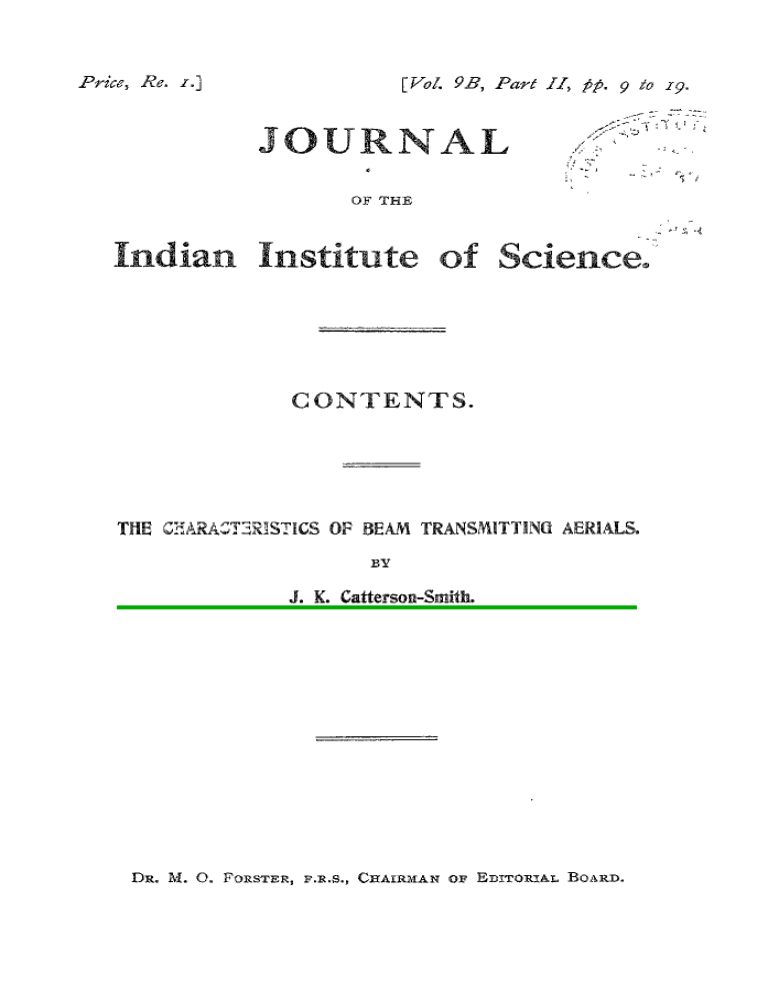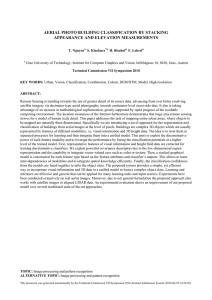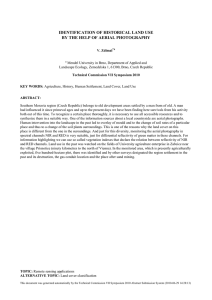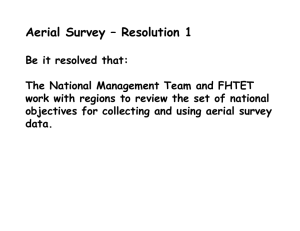a e 1.1 THE
advertisement

Price, Re. 1.1 OF THE e a THE GEARASTZRBSTIGS OP BE TRANSMITTING AERIALS. BY J. K. Gattersoa-Smit SYNOPSIS. T h e phases of the components of the radiated field of multiple aerial systems are considered and polar distribution diagrams plotted. T h e production of a single beam with minor secondary rays is dealt with by means of examples. Cylindrical parabolic and plane reflectors of the double grid type are contrasted. Methods of reducing dispersion in both vertical and horizontal planes are considered. INTRODUCTION. T h e extensive experimental work carried out by C. S. Franklin and others of the Marconi Wireless Telegraph Company has resulted in the successful development of several new types of directive aerials. These possess features of considerable interest and promise of practical utility, especially in connection with ultra-short waves. T h e original sheet-metal reflectors of Hertz were replaced at a n early date by vertical tuned wires arranged to form a cylindrical parabolic reflector at the focus of which the oscillator was placed. I n this form the reflector gives a considerable degree of concentration in the desired direction and such systems have been utilised (Marconi, J. Roy. Sac. Arts, 1924, 72, 607. C. S. Franklin, J. Imt. Elec. Ewg., T h e attainment of a beam by this means necessitates the use of a parabolic reflector which, having an aperture of several wavelengths, is consequently not altogether i. simple structure excepting with wavelengths of the order of ten metres o r less. Further, the whole of the power to be radiated must be supplied to the single oscillator at the focus of the reflector ; this constitutes a drawback to the system for large powers. A better arrangement of both radiator and reflector is the double grid form for the production of a single beam of exceedingly small dispersion. It is relatively simple to erect aerials of this type having, for instance, a width of ten wavelengths even for roo-metre wavelength transmission or reception. T h e whole of the radiation is then confined to within about six degrees o n either side of the centre-llne T h u s it may be concluded the successful generation of of the beam. beams has at last been accomplished and, unless the transmission from the beam stations now under construction reveals some unexpected phenomena, there is little doubt the majority of point-to-point transnlissions of the future will be of the beam type. P O L A R DIAGRAMS AND DISPERSION. T h e double grid aerial system comprises two rows of vertical T h e h n t row conductors separated by one quarter wavelength. forms the aerial grid supplied with equal in-phase currents, the conductors being spaced so that there is no resultant field in the plane of the conductors. T h e whole of the radiation takes place on the two sides of the grid of wires. O n e half of this is reflected by the adjacent parallel row of reflector conductors, and the resultant field produced by the combined aerial and reflector currents is zero in all directions other than within a few degrees of normal to the aerial on the side opposite to the reflector. Calculation of the directional properties or concentrating power of the grids does not present any difficulties, but it may nevertheless be of interest to examine the more important cases in some detail. In the first place the case of a neighbouring pair of identical simple vertical aerials may be considered. I t may be assumed that either aerial alone would set up a uniformly distributed field in all directions in the equatorial plane, taken to be the horizontal for present purposes. Also the field at any point may be taken as the resultant of the fields of individual aerials with due respect to their phase relations a t that point. Then, as is well known, under certain conditions the resulta.nt field will possess a certain degree of directive quality ; that is, at a distance, great compared to the wavelength, the field will vary with the angle 0 in Fig. I (a) between the receiver and the plane of the two aerial wires. T h e phase difference in the component fields depends upon the angle 6 and the distance separating the two aerials, and also upon the time-phase relation of the current in the two aerials. T h e time phase difference due to the distance apart of the aerials may be cos Brepresented by 4 = 2 ~d, 7 radians while that due to the current phase is represented by v. T h e resultant field therefore has conlponents the phase difference of which is ($ f +). !i E, be the component due to one aerial then the resultant will be given by (11 Case (.--The resultant field when H = go0 or 270" (normal to A B on eithei side oi the grid) is 72. E, where 92 is the number of aerial wires ; but when 8 = o or 180" the rewltant depends upon 4,'L and E, is zero when 7 7 9 is an odd multiple of that is when dl= n;2, 3x12, etc. Thus any number of aerials carrying equal in-phase currents may be placed in line so as to radiate a maximum field normal to the plane of the aerials and zero field along the plane of the aerials. The polar diagram given by equation ( I ) has double beam directive charactcri+tics which improve as 12 is increased lor a given value of the ratio d , ' that ~ is as the width of the grid aerial is increased. This is shown in Fig. I (6) for ~z = 2 , .G = o, and dl = h / 2 . The polar diagram for other values of n may be plotted as follows :(a) When n is an even number, j (z) ..] (3) E , = ~E, [ c o s $ ~ c o s ~ + c o s .~ .+. taken to ?Z terms. (6) When n is an odd number, E, = 2E1 [i cos @ + taken to Jf + cos + cos g$ f P$ f I -- terms. It is useful to denote the ratio of the resultant field at any angle to the maximum ficld at right angles, i.e., E,,h.E,, as the ' beam concentration factor ' or P, where E, is the field which would be produced by s single aerial with Ifiz amperes. I n a grid aerial there will be I p amperes per wire each contributing E, to the resultant field. as This factor is a measure of the theoretical 8ispersion of the beam changes from o to go degrees. I t follows from equations (2) a i d (3) that the beam concentration factor may be calculated from := i,[cos' -I-cos g + cos 545;+ . . . ] A (4) wher? ?L is even, or [ + + cosCb+ Is=; when 12 COS?$ -I- cos 3@i .. .] (5) is odd. The condition for E, = o is that 6 must be zero, and for a Learn of sinall dispersion this should occur at 8 = 0.1 or 0 . 2 radian. resultant field for two Cme 21 (Czt~matphase3 qt = poo).-The aerials with rE, spacing changes its directive characteristics with changes in +. Thus when .Ir = i 71 . ; 2 a . and d, =-, 4 if the current phase difference is ,: the resultant field is zero in one direction along A B (i.e., = o or 180 degrees) and equals 2E1 along the other direction Fig. I (c). The field is JzTE, on each side (8 = 90" or 2707 when (I, exceeds hi4. 0 Two aerials under these conditions give rise to a one-sided radiation but the wide angle dispersion limits its usefulness. The combination of two rows of conductors such as A, B,, A, B,, A, B,,etc., shown in plan in Fig. 2 (a) reduces the dispersion the greater the width of the grids relative to the wavelength. A single beam of small dispersion is radiated to the left or right according to whether the current in the conductors B, B,B,, etc., leads or lags by a quarter of a cycle to the current in the conductors A, A, A,, etc., in Fig. 2 ( a ) ,the two rows being separated exactly one quarter of a wavelength. If instead of supplying two-phase current to the two rows of conductors the rear row, B, B, B,, etc., are disconnected from the supply and tuned to the frequency of the aerial currents in A, A , A,, etc., the former will reflect the left hand radiation from the latter group. T h e fields due to the aerial currents A, A, A, and the reflected currents B, B, B, combine to give an amplitude in the direction 0 = 0 of z n E , provided the reflector grid is placed at XI4 behind the aerial grid and tuned accurately. T h e reflector conductors carry currents which differ in phase to the aerial current by (T -z ,. 5 X 1 the first term on account of the reversal of the electric field at the reflecting surface, and the second term on account of its distance from the aerial. Hence when the spacing is dz = =/4 the current in the reflectors. leads by one quarter of a cycle or T,'Z radians. It may be remarked that the magnetic field is reflected without reversal and the current in the reflector wires is an out-of-phase image of that in the aerial wires. T h e reflected and direct rays combine and the resultant field due to the double grid is given by ;- E, = A, and B,. 2 El. cos [ -4 ( I 7r 1 - cos 8) for a pair of conductors, e.g., d Thus E, = 2 E, when 0 = o and has approximately this value up to about 0 = 45" as shown in Fig. I ( 6 ) . LINEARCOMBINATION OF AERIAL AND REFLECTORWIRES. Each unit consisting of one aerial and one reflecting conductor contributes 2EI to the distant field along the centre line of the beam. On either side of the centre line the field E, for a wide range of 8 is 2 x n x E, and the dispersion measured by the field Ed at any angle 0 is given by :- Ed = E, x the beam concentration factor, or = a x 2. n. El where 8 is given by equations (4) or (5). 2 (6) 14 Example Z. Narrow A e r i a l a m ReflecLo~ol-(Fig. z).-In X double grid having 9~ = 4, dl = ;and d2 = the width of the aerial is (n - I ) d, = the phase angle is 6 = the current phase is from which :- 2v =- the case of a X --4. 3, d sin 0- = T. sin 0, and X 77 = 2 leading fj = 0 degrees 15 30 45 60 75 90 T h e conclusions to be drawn from the foregoing are :(I) The amplitude of the distant field on the centre line of the beam is independent of the width of the radiator. (2) The dispersion is reduced as the width, in terms of wavelength, is increased. (3) The spacing of the aerial and reflector conductors, (4)must b e made a small fraction of a wavelength if leakages or secondary fields are to be avoided. T h e amplitude of the secondary fields at various angles is usually small. In order, therefore, to obtain a concentrated beam, the width of the aerial may for instance be made equal to ten wavelengths while the spacing of the wires (dl)is reduced to one-eighth of a wavelength. BEAM CONCENTRATION FACTOR FOR LARGEVALUES OF ' Z '. T h e resultant of a large number of vectors each displaced by equal angles (@)is given by the chord of the circular arc subtended by t h e angle n.$; the length of the arc is n.E,. concentration factor, is given by :chord =arc B Hence the beam sin 5 2where 4 nq, - = 2 ~h 5sin e radians, and at any 2 angle B from the centre line of the beam the dispersion field is Ed = p x 2%. E, (7)- ANGLEOF DISPERSION. For present purposes this may be defined as the angle on either side of the centre line of the beam at which the field becomes zero, .or 6 when E, = o. This occurs when n x 4 = zrr or any even (8)multiple. Eza~npZe11. W d e Aerialand Reflector.-A double grid system about ten wavelengths wide has 80 aerial wires spaced cd, = hi8 in both aerial and reflector which are one quarter wavelength apart. From (7) and (8) the angle of dispersion is given by :0 x 8 = arc sin - - =arc sin - =5" 45'. ?idl 80 The field distribution is plotted for this aerial in Fig. 3 from equation No. 7, for which figures are given below :- T A B L E I. w = 80, 4 = h/8, and d,= h/g. .. 0 degs. radian ----- ~ 1 3 - Note.-The functionhas been termed ' cursin 0 ' by Silvanus P. Thompson who gave 0 some values for it in J. Inst. E k . E w . , 1915, 53, 240. Experimental data relating to such small dispersions have not yet been published, but there appears no reason lor doubting the practical possibilities of high degrees of concentration in one plane with wavelengths up to about 100 metres. The osci1la:or A is placed at the focus as shown in Fig. 4 distant ~ i from 4 the reflector apex conductor 0 in which the current Ieads by 90 degrees. T h e current in the reflector conductors at B, distant X/Z, is in-phase with the oscillator current and the reflector current beyond this point bas a lagging or leading phase a c c o ~ d i n gto the distance. I f the reflector is to confine the radiation within an angle of dispersion 6 its size is determined by :h Aperture = i (-L.- 2) 2 sin 6 tan 0 For instance, if the dispersion is not to exceed 1 5 degrees on either side of the centre-line the aperture must be 3.85 wavelengths. The aperture increases rapidly with the concentration. C, S. Franklin has published (1&st. . EIcc. Eltg., 1922, 60, 933) polar diagrams of his observations made with 4.28 metre wavelengths for a reflector of 2.57 aperture etc., measured at four miles, which are in close agreement with the calculated field distribution. This type of reflector appears more suitable for very short waves. and moderate distances of transmission whereas the double grid plane reflector lends itself to great concentration of the beam for wavelengths up to roo meters and the greatest distances. T h e reflector aperture required for a dispersion of only 5" 45' works out from equation (9) as ninety-seven wavelengths compared with a plane reflector (see p. 15) which is ten wavelengths wide. CONCENTRATIONI N T H E V E R T I C APLANE. L The aerial conductors must be supplied with equal currents and for this purpose feeder circuits have been developed by the Marconi Wireless Telegraph Company (Id. Pat. Spec., No. 10,420 and No. 10,421, 1924) which show vertical wires of x/3 length spaced h/8. as practical dimensions. T h e wires being connected in parallel along top and bottom and fed at points along the base separated preferably by h/2. This patent discloses the use of two or more tiers of such grids with electrostatic coupling and giving an in-phase current distribution all over the units forming the grid. In this way aerials and reflectors may be built with an area of several square wavelengths radiating energy substantially in one direc. tion only. Combined with similar plane reflector receiving aerials it is claimed that a great magnification of the received signals results. Aerials of one or more wavelengths in height give rise to a concentration in the vertical plane as will be examined for the case of a type, of more recent date, developed for this class of transmitter. Inn'. Pd. Sgec., No. 11,543, 1925 : Marconi Wireless Telegraph Company, divulges means whereby grid aerials nlay be made to carry stationary waves of current of the same phase at all points. By this means extreme sharpness of concentration of the field in the vertical, a s well as in the horizontal, plane becomes possible and a beam of small solid angular dispersion obtained. Referring to Fig. 5 which represents a simple oscillator, with current distribution as indicated by the sine curve, the polar distribution of the field in the plane of the oscillator is approximately ;- E = E,,,.cos 8'. T h e same effect wouId be produced if the oscillator were replaced by an aerial one half a wavelength long excited at its base by capacity coupling in the ordinary manner. If now the applied frequency be raised until the aerial is one wavelength long the stationary waves of current take the form of two loops ; maximum amplitude occurring at & and 2 wavelength up the conductor. In this case there can be no field at right angles to the aerial on account of the phase opposition of the currents in the two loops ; on the other hand radiation at about 45O and I 35" all round the aerial will take place. On raising the applied frequency still higher a condition will be reached when three loops of current form, the maxima occurring at 2, 2 and 14wavelengths from the base. The aerial is then 13 wavelengths in height and the phase of the current loops at the & and 14be the same and opposite to that at the 3-point, T h e polar points diagram for the radiated field will become a six-loop figure, a s shown in Fig. 6, and it is clear that for NL loops of current there mill be 2nl loops in the polar diagram. If by some means the radiation from alternate current loops such as AB, Fig. 6, be suppressed, the pohar diagram reduces from 2 m to 2 loops only, and a high degree of sharpness obtained as NL is increased. The patent referred to secures this condition, at least approximately, by forming the portions, such as A B in Fig. 6, so as to anncl! the radiation therefrom. This is accomplished by either doubling that part of the aerial wire back on itself or by replacing it with reactive coils, etc. The phase of the current in the remaining portions of the long aerial is substantially the same throughout and the effect of the loops is additive at right angles to the aerial. This is indicated in Fig. 7 which is drawn for an aerial of vertical height 4-h carrying four current loops ot the same phase and three current loops on the non-radiating portions. The concentration in the vertical plane for a grid oi such aerial conductors may be calculated in the manner already given for the horizontal concentration. T h e angle of dispersion in the vertical plane is given approximately by equation (8) ; thus for I/Z current loops, in += 271 or:+ hence =2 7 ~ 1 ~ ~ += also 61' ; T arc sin sin 61' 5. 7% Thus when m has the value given in the first column of Table I1 the corresponding vertical dispersion is given in column three. T A B L E 11. Without Reflectov. WRTICAL DISPERSIOX PZ Degrees and minutes 90' 0' 41a 45' 3;: 19' 30' 16' 35' 14" 30' 11' 30' 5" 45' = (10 A high) :;2 From this it is seen that a plane reflector grid 1 0A wide and ro A high should produce a single beam concentrated within so 45' of its centre line both vertically and horizontally. A wide field for research is opened in connection with short wave reflectors giving such concentrated rays, the future applications of which appear unlimited. .-. PRINTED .4hTD PIIRI,KSIIISI~ BY GEORGE KIENNETTI dT THE DIOCESAN PRESS msr sox 455, MADRAS-IOX. C13108 AERIAL SECONDARY, PRIMARY HORIZONTAL POLAR D/STR/BUT/ON PRIMARY BEAM DLWERJIDN JD4S' -8sr/c 3 0 -8- AERIAL AND REFLECTOR (/O-WAVELENGTH). RCi 5- I VERTICAL FIELD.



